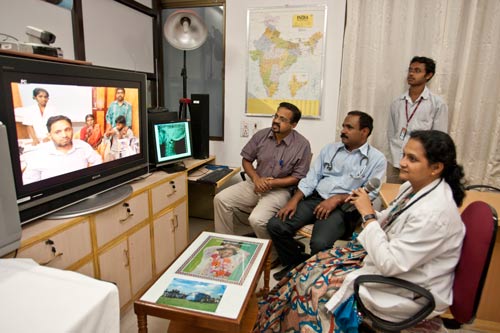ISLAMABAD ( ABRAR MUSTAFA )
COMSATS Internet Services (CIS) Islamabad is a pioneer in the field of Telemedicine in Pakistan; having successfully implemented a project of Establishment and Operation of Tele-health Clinics Networks. Under the aegis of COMSATS; 12 rural Tele-health clinics are operating at:
- BHU Gokina&MehraBeri (Islamabad)
- BHU Dagai (Swabi)
- BHU Wahdat colony (Quetta)
- BHU Maraka (Lahore)
- BHU Muzaffarabad& Chak5faiz (Multan)
- BHU Sangu (Peshawar)
- BHU Shadoband (Gwadar)
- BHU Ubhri (Khairpur)
- BHU Kingri(Musakhel) &
- Tele Health Center Mediterina (Rawalpindi).
These clinics are connected via dedicated broadband Internet with CIS Tele Health Centre, Islamabad where a panel of doctors/specialists is available for medical consultation to the patients visiting these clinics. These clinics are equipped with latest means of video conferencing, computer systems, and Tele health equipment such as digital stethoscope, vital signs monitor, examination camera, ultrasound probe, ENT scope, ECG gloves etc. Patient’s data is maintained on CIS developed web portal for which patient’s software has been arranged. More than 45,000 patients have been examined and advised todate.
Methodology
Tele-Health service by CIS is carried out by using the latest means of video conferencing. Paramedic staff at the connected Tele-health clinics, assist the medical specialist at the Tele-health Resource Centre to carry out initial checkup of the patient using digital equipment such as: digital stethoscope, vital signs monitor, examination camera, ultrasound probe, ENT Scope, X-ray unit, ophthalmology, ECG Glove, etc. Patient data collected during the initial checkup by the paramedic staff can be viewed simultaneously by the doctor at CIS Resource Centre in Islamabad. The doctor then provides medical consultation to the patient and transmits prescription to the remote end, a print out of which is given to the patient by the paramedic staff. Computerized database of patients and their medical history is maintained at the Centre where dedicated computer server with sophisticated peripheral devices and software is installed. Patient that require further examination and treatment are at times also referred to the nearby hospitals. Data of such patients may be transferred to the referral hospital for guidance as per the advice of the doctors.
Telemedicine holds promise as a means of increasing access to care and improving health outcomes. Some analysts also see the potential for Telehealth to reduce costs. Telehealth has existed in some form for decades. For instance, radiologists and dermatologists have relied on store-and-forward techniques, for instance transmission of videos or digital imagery (e.g., X-rays) through a secure electronic communications system since the 1980. However, significant advances in telecommunications, including the improvement of high resolution imaging and greater access to broadband, have accelerated the use and availability of telehealth. The availability of telehealth is of particular interest for patients who live in areas that are inadequately served.Access to certain medical specialties, such as oncologists, is limited in rural areas. Currently, 75%Pakistanis reside in Health Professional Shortage Areas, rural and urban areas with shortages of primary care providers.Of special concern are rural individuals who have higher mortality rates; a greater chance of being unnecessarily hospitalized; and have negligible access to specialists as do persons living in cities.
Telehealth appears to hold particular promise for chronic disease management. Chronic disease accounts for approximately 75 percent of all health care expenditures. Many persons with chronic conditions are elderly, and therefore have mobility limitations. Moreover, people with multiple chronic conditions typically require frequent visits to clinicians. Ensuring ready access to care for such individuals may help avert costly emergency room visits or hospital stays.
Telehealth has great potential to increase access to and quality of healthcare in rural communities. Technology now allows rural patients to see specialists without leaving their communities, permits local providers to take advantage of distant expertise, and improves timeliness of care.Using telehealth services is more feasible for rural healthcare facilities than staffing the facilities with specialist providers. Telehealth allows specialists to visit rural patients virtually. Specialties provided to rural communities via telemedicine include:
- Teleradiology
- Telepsychiatry
- Teleopthalmology
- Teledermatology
- Teledentistry

